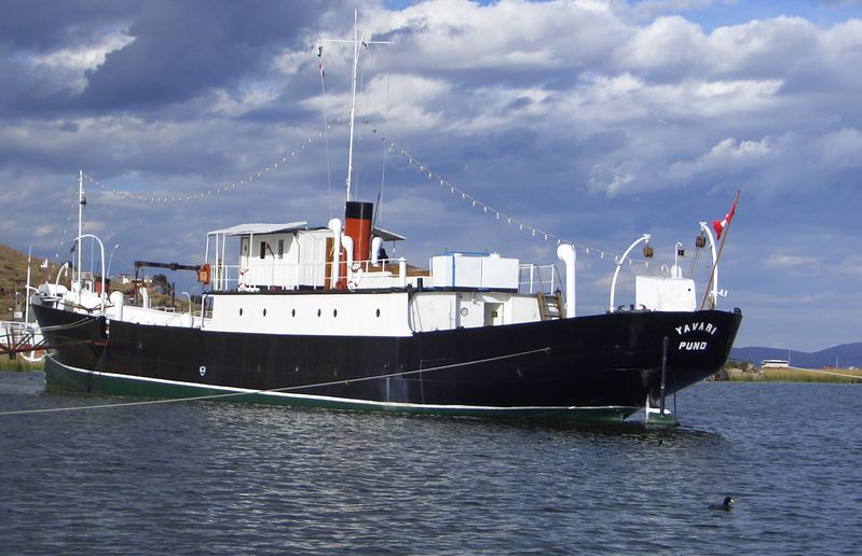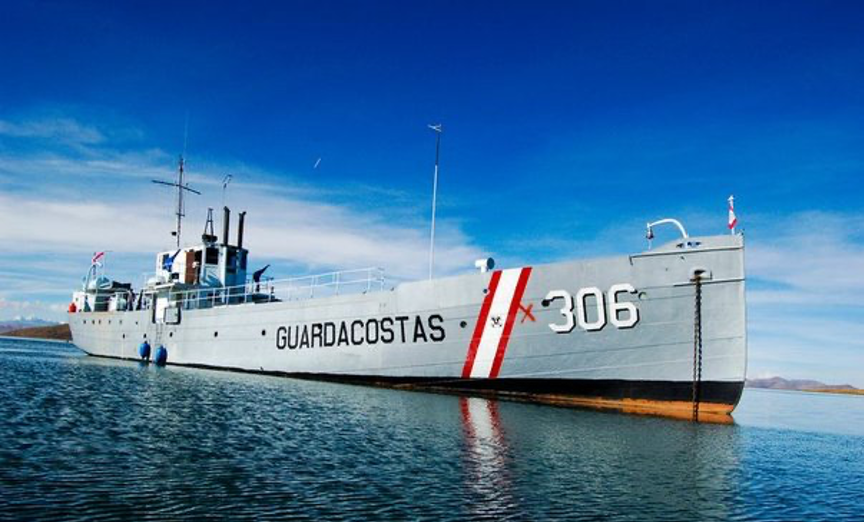Gunboats on Lake Titicaca – Yavari and Yapura
After living and working a few years in Latin America I am forever intrigued by the involvement of the Gibbs family in that part of the world. This is the extraordinary story of the steamships Yavari and Yapura, which have sailed for many years on Lake Titicaca, the highest navigable lake in the world.

In 1861, the Peruvian Government of Ramon Castilla, ordered two small cargo-passenger “gunboats” for Lake Titicaca. Already enjoying the wealth from the guano industry on the coast, the Government looked to exploit the natural resources of the southern highlands or altiplano region around Lake Titicaca.
Here lay the potential for trading Peruvian copper, silver, minerals, wool and timber and the riches of the rainforest from Bolivia with manufactured goods from Europe. Through the agency of Anthony Gibbs and Sons, the Government commissioned the James Watt Foundry in Birmingham, England (where steam was first harnessed for industrial use) to build the ships that would collect goods from around the lake. In 1862 Thames Ironworks and Shipbuilding Company built the iron-hulled Yavari and Yapura under contract to the James Watt. The ships were designed as combined cargo, passenger and gunboats for the Peruvian Navy. The Yavari and Yapura had James Watt 60 horsepower (45 kW) two-cylinder steam engines, which were fuelled with dried llama dung. These were replaced in 1914 with Swedish Bolinder four-cylinder semi-diesel engines.
Without a rail link to the lake at that time, all cargo had to be carried up on mule back. Therefore, the ships were built in kit form, with no piece weighing more than 3½ cwts, the maximum carrying capacity of a mule.
On 15th October 1862, the “Mayola”, bearing the two ships and eight British engineers from London, having rounded the Cape Horn, docked at Arica – a Peruvian port before the War of the Pacific – and discharged the packing cases and pieces of the Yavari and the Yapura, from where they were moved by train 40 miles to Tacna. The Peruvian Navy then faced the daunting task of transporting 2,766 pieces and two crankshafts 220 miles over the Andes to Lake Titicaca, which is 12,600 feet above sea level. It took seven years to transport the pieces across the Andes by mule and then assemble the ships on the lake. The Yavari was launched in 1870 and the Yapura in 1873. The Yavari, as a State Registered Museum, is now berthed in Puno Bay, outside the Hotel Sonesta Posada del Inca, Puno. A 40 metre pontoon gives access to the vessel either by land or by boat, and visitors are warmly welcomed.
A third vessel was even more unusual. In 1869, Antony Gibbs and Sons, London, contracted with Alexander Stephen & Sons Ltd. of Kelvinhaugh, Clydeside on behalf of Senor Geromino Costa, of Puno, Peru, for an iron sailing schooner, dimensions 48 ft. x 10 ft. 6 ins. x 6 ft. depth, for trading on Lake Titicaca, which is about 120 miles long and between 35 and 45 miles wide. Senor Costa’s instructions were that no single piece, save the spars, was to be longer than 18 feet, nor more than 150 lbs. in weight, as mule-back was the only method of conveyance up the steep gradient leading to the lake. The schooner, which was named the Aurora Del Titicaca, was built in the shipyard, being completely fitted up, masted, rigged and sails bent. After being all carefully marked she was taken to pieces, packed, and sent round to Liverpool, whence she was shipped to Peru. On arrival everything was successfully transported up to the lake and reconstructed at the lakeside.

In the early 1980s the Yavari was beached and left to rust. However in 1987 an English woman, Meriel Larken purchased the ship for $5000 and began collecting money to undertake its restoration. The work is now virtually completed and there is a museum on board and overnight accommodation is offered.
The Thames Ironworks and Shipbuilding Company’s football team became West Ham Football Club. In August 2015 twelve young Hammers – supporters of West Ham – trekked across the Andes from Tacna to Puno on Lake Titicaca. When they arrived in Puno they were welcomed on the Yavari and on 28th August set sail on the second maiden voyage of the ship. On December 1st 2015, the Yavari received her licences from Peru’s Maritime Authority to sail as a passenger vessel for 40 passengers and ten crew.
Michael Palin visited the Yavari on his journey round the Pacific – Full Circle (Episode 8). The Duke of Edinburgh was also an enthusiastic supporter.
The Yapura was renamed the BAP Puno and used as a hospital ship. It is now used by the Peruvian Coastguard Service as Lake Titicaca is bordered by Bolivia and Peru. The ship captained by Navy Lieutenant Cristian Espinoza also visits the islands and peninsulas of the lake to bring supplies and medical services.
Article courtesy of David Hogg
Meriel Larken’s book – The Ship, The Lady and the Lake – tells this remarkable story. This web site is also a useful source of information. https://www.peruyavariexpedition.com/author/yavariperuexpedition/
More about these two incredible boats is available on Wikipedia – Yavari and Yapura
